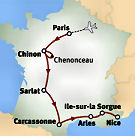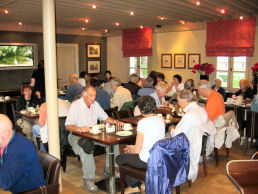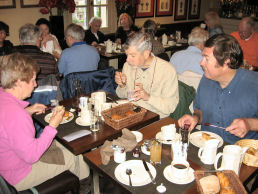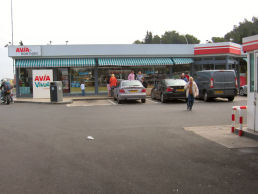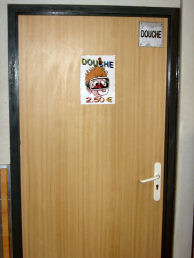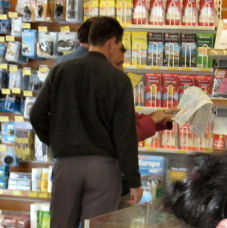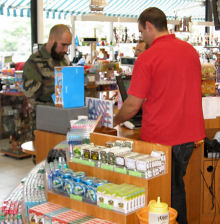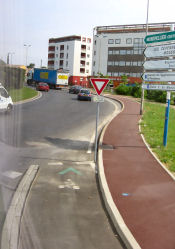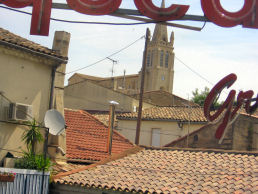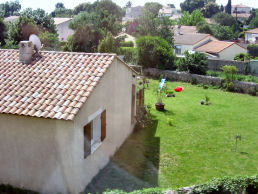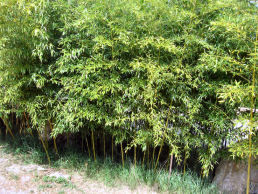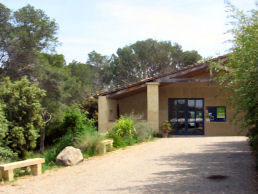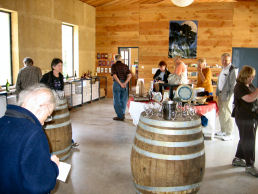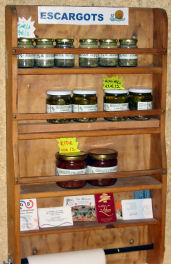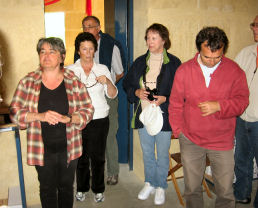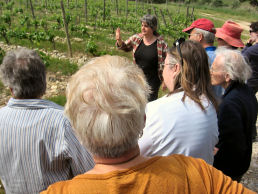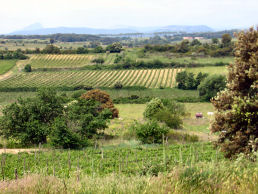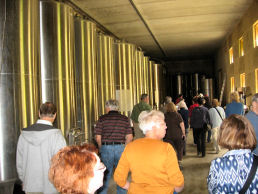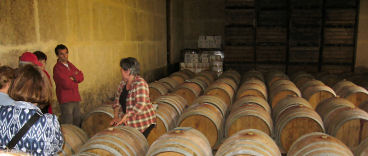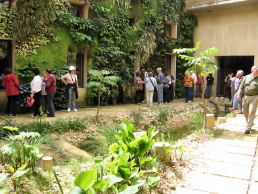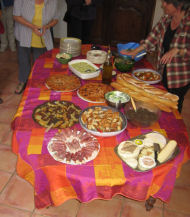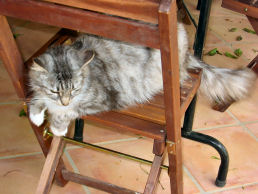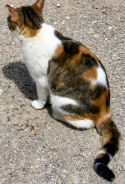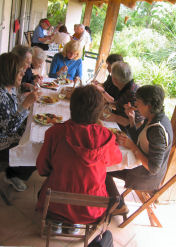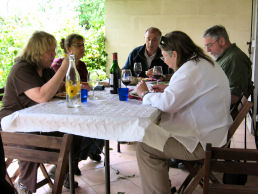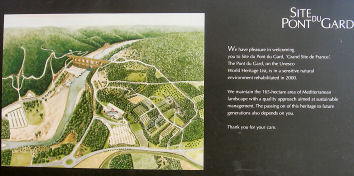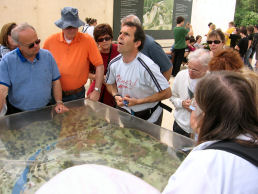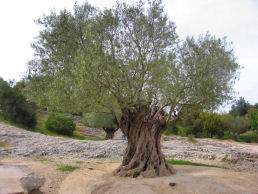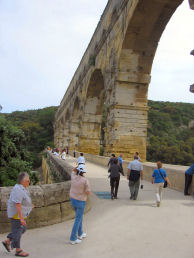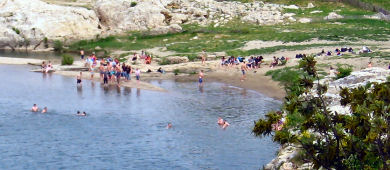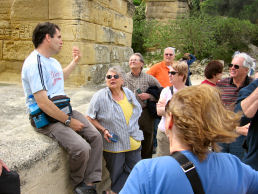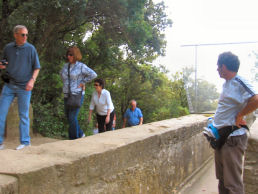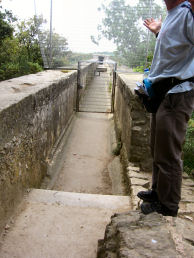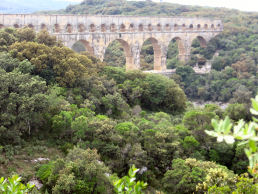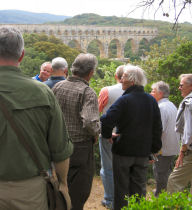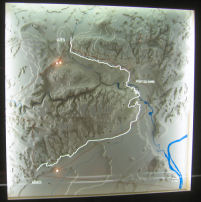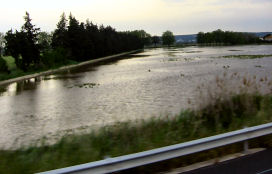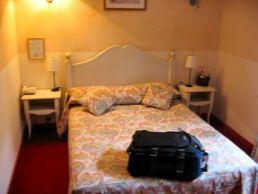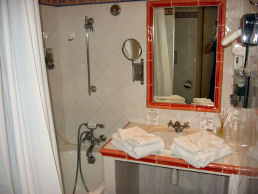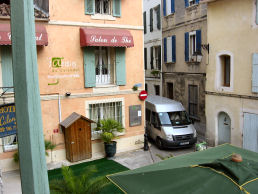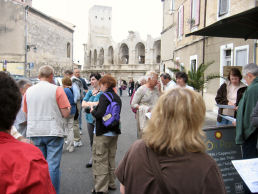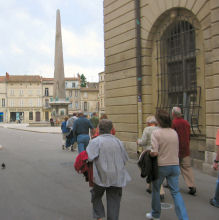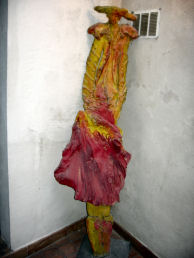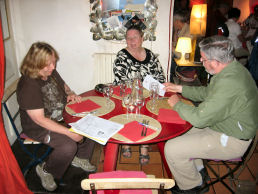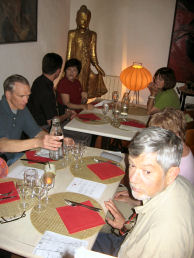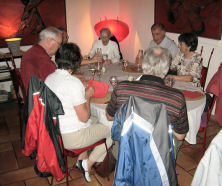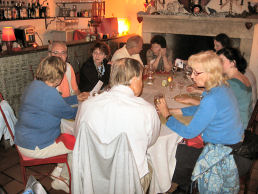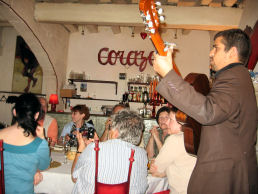I woke up at 4:15 in the middle of a very vivid dream. The users of our system in Radio Shack’s advertising department were very upset at us because they thought that our prices were too high. Radio Shack had been our customer in the nineties, but they had stopped using the system when they outsourced the buying of newspaper advertising seven or eight years ago. So, this particular dream was more amusing than nightmarish. I must have fallen back to sleep almost immediately, because the next thing that I knew it was 6:15.
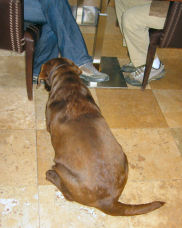
We had to walk over to the other hotel for breakfast. The settting was quite elegant. They brought each individual or couple a pot of coffee. I neglected to record anything about the quality of the breakfast, so it must have been pretty good.
I took advantage of the opportunity to introduce myself to Paul and Kathy Lantz. Paul identified himself as a semi-retired electronics engineer; Kathy was retired from US West, the telephone company (in many different incarnations) in which she had worked in various phases of IT. Jim, Tom Stan, and Loraine joined us at our table.Sue was late for breakfast, but at least she managed to get something to eat. She left her backpacks in the lobby before she left. I made sure that they were stowed on the bus.
In order to prevent another fiasco, I stopped at the door of our room just before closing it for the last time. I went back and searched the whole room rather thoroughly. I found one of my black socks under the bed and a pen under the nightstand. The next destination on our itinerary was the region of Provence, specifically the town of Arles, our home base two days and three nights. Provence began at the Rhone River, so both Arles and Avignon were right on the border with Languedoc.Our route covered mostly flat farmland. Patrick informed us that the Canal du Midi ended in a lake near the Mediterranean called the Étang de Thau, which was, according to Patrick, renowned for its oyster beds. Another canal connected the lake with the Rhone River. Between Béziers and Montpellier I noticed quite a few poppy fields.
We took a break at a truck stop that had only one restroom open. Even the men were forced to wait in line, an unusual and disorienting experience for our gender. Our instinct in such circumstances is to look for a tree. The ladies did not appreciate the arrangement at all.
From a distance I spotted Patrick and Olivier looking over a map. I figured that something must be amiss. I took a photo of them in case I was right.A few soldiers with beards were in the rest stop with us. It was a little discomforting to encounter guys wearing camouflage fatigues in the south of France. I deduced that even Old Europe must have become more militaristic in the twenty-first century. By the way, those beards would not have lasted long in this man’s army.
Patti purchased a cappuccino of some sort. I found a bag of potato chips with a picture of a steak on it. The label said Pavé Grille, which according to Tom Corcoran’s little French dictionary, meant a grilling stone. Gigi told me that they were barbecue flavored.[1]
Patrick appeared on the bus’s television set for a second just to show that he could do it. Then he announced that there had been a big truck accident on the A9. Drivers were reporting a five-hour delay. Olivier’s plan to avoid the tie-up entailed negotiating side streets through Montpellier, a fairly large city. This did not promise to be a pleasant task. We exited the highway and made an unscheduled tour of the regional capital. We changed directions a number of times, and we negotiated countless roundabouts. Olivier earned his salary on this day.On the other side of the city we went through the town of Castries. I tried to take some photos.
Silvienne said that Serge’s parents had both been math teachers. In 1978 they both abandoned the world of differential equations and purchased the farm. In addition to grapes they grew cherries, olives, peaches, and other fruits. They produce three types of wines – whites, reds, and rosés. The AOC for their wines was Languedoc St. Christol.
After the introductions we were allowed a bathroom break. Since I had skipped the line at the truck stop, this was music to my ears. The weather was also growing warm, so I stripped down to shorts and my Pope Art tee shirt. Dave put on his red hat and posed for me.Silvienne told us the names of the other grapes that they grew, but I did not record them. She emphasized repeatedly that they were limited to grapes that were appropriate for the Mediterranean climate, an attitude that she called “terroir.”
2003 had been a terrible year for them because of the paucity of rain and persistent heat.[3] The vintage had to age in barrels and bottles for a much longer time than usual.
The winery’s rosé used the same grapes as the red. Normally the grapes started producing in three years, but the period had lengthened in recent years as a result, at least according to Silvienne, of global warming. They have always harvested the grapes by hand. They had one vine that was eighty years old, and it was still producing small grapes. Normally a vine’s productive period was from thirty to sixty years. I noticed that they let weeds grow between the rows of vines. Silvienne mentioned that the insects were attracted to the weeds, not the vines. I will try to recall this explanation the next time that someone makes calls attention to the abundant dandelions and crabgrass in our yard. Serge had recently built a large new structure made of two-ton stones extracted from a local quarry. Silvienne proudly announced that he had finished the lower floor in only four months. The soil was very solid, so the slabs of concrete served as the foundation. They paid close attention to the environmental impact and the use of water in the construction. The lower floor was below ground. She emphasized that they used gravity, not pumps, to feed the grapes into the machines. All the air in the building could be recycled in only two hours. They used only a small amount of water to clean the tanks, which were stainless steel. All of the winery’s Chardonnays and some of the reds were aged in oak barrels. The Chardonnay customarily was aged for one year, and the red wines aged two years. They decided when to stop the maturation process by tasting. The winery had only two permanent employees, but it customarily took on another two or three in the spring. Up to ten additional people were required for the harvest in the fall.The rules for the AOC designation for Languedoc required at least two grapes. This seemed weird to me, but who am I to tell the French anything about wine?
Serge repeatedly received calls on his cell phone. This drove home the point that he was a businessman who had more on his mind than entertaining American tourists. Mike asked how many bottles they sold per year. The answer of eighty-thousand sounded like a lot, but when I compared the likely income with that of our little company I wondered how they managed. Their per unit costs were probably pretty low, but the overhead must have been significant even if they owned everything and watched their costs carefully. And one disastrous harvest would mean …
Silvienne showed us a courtyard that featured “green walls.” Moss and plants were actually growing on the walls. They supposedly kept the interior cool. I supposed that they must have had some effect, but I wondered if it were worth the effort. I imagined that you would have to postulate a fairly large value for the esthetic component to justify the work and the cost.They served us a very nice lunch. Laid out on a circular table were all kinds of breads, meat, cheeses, fruit, and lots of other concoctions. We all loaded up our plates. Three types of wine – white (2007), red (prestige 2007), and red (reserve 2006) – were available for us to sample. The other diners argued about which was best. They all seemed pretty good to my uneducated palate. As wine-tastings went, it was somewhat disappointing. As lunches went, it was quite good.
I had my first ever European sneezing fit[4] at lunch, but it was not a serious one. I wondered if I might be allergic to something that was in blossom on their farm.The women complained that there was no water for flushing or for hand washing in the ladies room at the farm. Bitch, bitch, bitch.
After lunch Olivier set the bus back on the highway and headed it toward Pont du Gard. The driving was stop and go for a few minutes, but after we passed the site of the accident, which was clearly identifiable by the destroyed guardrails, it was pretty smooth sailing.
Patrick led about half of us up to the top of the aqueduct and beyond. One could see along the side of the hill where parts of it were still in evidence. We also had excellent views of the river from there. Patrick was obviously excited about the aqueduct. He said that he wanted to put together a group to hike its entire distance.
Until recently one could walk across the top of the Pont du Gard. Patrick, Gigi, and Roscoe had done it. I would have been up there in a flash if they had still allowed it.I returned ahead of the rest of the group to search for napkins or paper towels. I could not find any, so I stealthily filled my pockets with toilet paper. Sue gave me a pack of Kleenexes that she found. I saved them for an emergency.
I visited the museum that explained how the Romans lived and some of the mechanics involved in the process of delivering water. It was surprisingly spacious with a lot of time-consuming oral presentations. I could not say that I got a lot out of it. My concentration level was not very high. I may have been too nervous about not having enough tissue paper in which to blow my nose. Quite a few members of the group purchased ice cream cones. I milled around the retail area and waited to follow someone to the bus. It was a good thing that I did. If I had been left to my own devices, I would have gone the wrong way. On the bus Patrick delivered a short history of Provence. The Greeks had traded there, but they never conquered it. They founded outposts in Nice and Marseille. I thought that I heard Patrick say that the Rhone River was named after the island of Rhodes, but that is not consistent with what I discovered on the Internet. It was quite possible that I misunderstood him.
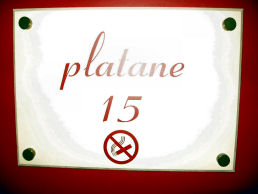
The pope came to the area in 1309, exactly seven hundred years before we did. For seventy years, the Bishop of Rome lived in southern France. After that, two antipopes also resided in Avignon before the King of France drove out Benedict XIII. The pope’s summer residence here was called Châteauneuf-du-Pape, and it produced very good wine.
In the French Revolution, The Marseillaise (actually written by someone in northern France) was brought to Provence by a division from Marseille. In the twenty-first century the song was considered controversial because the lyrics are so polemical and arguably racist:
…Qu'un sang impur abreuve nos sillons.
… Let impure blood water our furrows.
Olivier drove into Arles, and we checked into our hotel, Le Calendal, which was right next to the Roman arena. We were assigned room #15, the one French number that I would not have been able to recognize when spoken aloud. It is pronounced “kants.”
It was quite a trek to the room. We had to go through the breakfast area then up some stairs then down a corridor. The signs with the room numbers in our corridor also had a one-word name on them. Our room was named “Platane.”
We had enough time to shower and change before dinner. The wireless reception throughout the hotel was excellent. I was able to send e-mails with no difficulty using the Orange SMTP server. Dinner was at a restaurant named Corazón that was a few minutes walk from the hotel. Patrick reminded us that the drive from Arles to Nice would be the last time that we saw Olivier. Tom Stan suggested that the hat be passed for a tip for Oliver. Patrick said that we could do whatever he wanted, but that we should know that he would tip Olivier on behalf of ETBD.We had ordered this dinner on Thursday, but few people recollected their orders. Our table waited a very long time to be served. Patti, Sue, and I had eggplant stuffed with goat cheese, tomatoes, and some other stuff. Tom had a lump that contained beef and some vegetables covered with a sour sauce. I found the appetizer to be OK, but Patti thought that it was too sweet. Tom, Sue, and I had scallops and shrimp on a skewer over rice. We all thought that it was virtually tasteless. Patti had duck and potatoes, and she liked it. Tom and Sue had chocolate lava cake for dessert. Patti and I had three weird-tasting sorbets for dessert. The cake was probably better.
I learned from Patti about Donna’s identical triplet sister and brother. I argued with myself over whether I should approach Brad and tell him how much sympathy I had for him. It must have been tought for him to live with the fact that the woman whom he married could not stand his very presence and, only a few month after the nuptials, had blackmailed her sister into taking her place.It was an interesting idea to play around with, and I have done worse things, but I decided not to pursue it.
A gypsy guy played guitar and sang some songs, about half of which were pop tunes redone to a salsa beat (at least Sue told me it was a salsa beat; I wouldn’t know a salsa beat from beet salsa). I thought that the music was awful, but most of the people at two of the tables seemed to think that his music added a great touch to the meal. The musician tried to sell CD’s at the end, but I did not see anyone besides Jacqueline purchase one. Patrick played a few chords on the guitar, too.
Olivier’s wife attended the dinner. All the women remarked about how pretty she was. Tom remarked that Olivier was pretty, too. Patti was dumbfounded at this evaluation. I outlined our rail schedule for Patrick and asked him whether we should buy a rail pass. He said that he did not think that it would be worth it.We were all disoriented, so we walked back to the hotel with Patrick. We arrived just ahead of another group that had departed well before we did. Evidently they selected a longer route.
Sue and I gathered together our laundry, and Sue dropped two bags of it at the desk. She also picked up some ice for her knee.
I went to sleep with the depressing convinction that Tom would surely be completely out of commission the next day, and the rest of us might well be only a day or so behind him.
[1] I vividly remember being duped into buying barbecue-flavor potato chips in Rome in 2003 by the phrase “extra gusto.”
[2] That was true as far as it went, but they were also knights who put plenty of people into hospitals as well. Sue and I had visited their former headquarters in Rhodes. I was familiar with the Hospitallers for their role in the incredible story of Djem, the Turkish prince.
[3] We were in Italy that May and early June. There was record-setting heat then, and it got much hotter in the subsequent months. We encountered almost no precipitation at all in three weeks.
[4] At home I frequently cannot stop myself from sneezing violently for a few minutes. My record is ten titanic sneezes. One of our clients once thought that I was in danger of dying during a particularly violent attack. Once I stop, however, there are almost never any residual effects.
